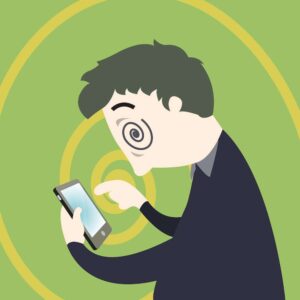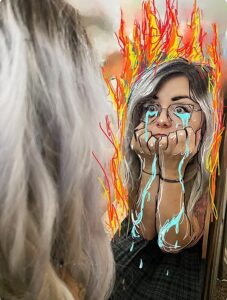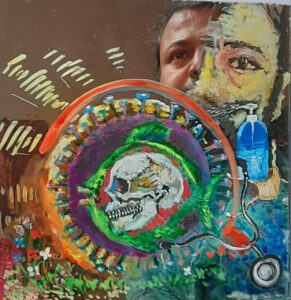–by Elena Morizio
–Reading Time – 18 min Approx–
— Continued from Chapter 1..
I told you about the Age of Reason and plagues. I told you about how the past resonates and it is a reminder of our pandemic times, of the modern man and his technologies.
 Specifically, how Art has expressed itself in all this? How did it tell us, becoming a precious witness, of man’s social, cultural and existential evolutionary process up to now?
Specifically, how Art has expressed itself in all this? How did it tell us, becoming a precious witness, of man’s social, cultural and existential evolutionary process up to now?
Just look at the paintings of the Enlightenment: the latter, of which I speak in the previous article, was a cultural movement of the eighteenth century, following great plagues. The Enlightenment has been the result of many events and choices: first, a clear separation of man from the religious dogmas of the time; second, man’s absolute adherence and inseparable association with science and logic. Result: the loss of one’s own feeling of being authentically a spiritual part of the surrounding reality.
Even then man faced death, and in that case he reacted with rationality, and this is what we can observe in the paintings of the time: control, composure, order, authority in exposing one’s knowledge about the things of the world. Even art had to respond to rational criteria, rejecting any excess!
What do these paintings convey to you? What emotions? Forget what has been written about them, on an artistic level. Listen to your inner feelings: do they stiffen you as they stiffen me?
There is freedom of thought, of course, there is revenge against past religious limitations, but there is no fluidity in their bodies. Not real connection and balance with the surrounding reality.
And now let’s go back to the art of our day, the art of the 21st century pandemic:
I bring you here photographic examples of artistic expression that I collected for my worldwide project Reflections for Change. They are works that speak of a man who has faced a forced lockdown, finding himself in a silent dialogue with himself.
What did he hold on to? What did he choose to be faithful to? There are curved lines, there is harmony, there is the discovery of our internal worlds and of reality as a whole. Be it physical and spiritual.
“Me and the whole of which I am a part. Me and everything to which I belong to. I, who am body-mind-spirit. ”
It is not a simple observation of the reality around us, but understanding our interdependence with it. Don’t you grasp the return of man to his origin?
I have often received drawings with universal symbols such as the spiral, drawings that came from every disparate corner of the globe! The spiral is one of the primordial anthropological symbols par excellence, it is a connection to the whole creation. This is the call to which man no longer wants to turn his back, aware that logic does not have all the answers. And the solution is not in scientific excesses, nor in religious and dogmatic excesses. But it resides in a balance between what it is outside and what it is inside us that primordial man knew.
Only by returning to the origin we will be able to grant ourselves a future.
Other times the drawings are essential geometric lines that hide a message:
“We have to go back to the essence!”
 In these works, man looks at himself in the mirror at the cost of facing everything that is hidden, uncomfortable and unacceptable. Because he understood that it is the only way to be, despite the virtual, technological, alienating and dehumanizing reality that tries every day to plagiarize him, to detach him from his emotions and reality.
In these works, man looks at himself in the mirror at the cost of facing everything that is hidden, uncomfortable and unacceptable. Because he understood that it is the only way to be, despite the virtual, technological, alienating and dehumanizing reality that tries every day to plagiarize him, to detach him from his emotions and reality.
The digital world alas has a double face: it connects us to the world, with which we share thoughts, reflections, emotions. But at the same time it tends, as I have already explained in the previous article, to hypnotize us to the point that we forget to realize the life that passes, to watch the sunrises, the sunsets as well as to feel part of the mystery of creation, simply by observing, for example, the indissoluble link between the bee, the flower and its aroma for which the bee lives.
Works of art through which often shouts that ecological and universal sensitivity that has never abandoned us.
There is awareness of what we will encounter if we do not return to Nature, the great artificer of all those instincts and emotions that the human being is meant to express!
Society has controlled us, drained us, made us and shaped us to its liking. That society which is nothing but what each of us has constituted.
Us and our fear of being, fear of our potential, fear of our greatness!
If the art of the 1700s, as a result of its plagues, speaks of control, the art of 2021 speaks of “abandonment”, that is letting go of control that has made us easily manipulated slaves for too long …
And inevitably, facing the word manipulation, I can only lead you to the psychological term “impasse”.
The impasse is the crucial point of our growth and maturation process.
It is that position in which we no longer have environmental or family support, but we have not yet achieved authentic self-support (economic, emotional, existential).
In nature, the transition from support to autonomy is a spontaneous, inevitable transitory phase.
In our lives, however, it often becomes a limbo, from which sometimes we never get out. We adapt to society, to what it, together with our family, considers most right for us. We depend on them, because we have learned, under deception, that it is only by consenting to their will that we could receive the love we so long for. We choose a role, rarely corresponding to our true nature, which in one way or another will try to make its voice heard, often in the form of neurosis, psychosis, control.
It is the simplest way. We create an illusory reality around us, adorning it with non-existent fantasies and beliefs: “If I decided to realize myself for what I really am I would be judged, excluded and never loved again.” But it is thanks to the courage of being ourselves that we could give ourselves the opportunity to experience authentic Love.
 There are two possibilities in this process: the child will grow up facing his frustrations and shadows and become independent, or he will be spoiled. In the latter case, he will not need to mobilize his resources and thus understand that he will be able to take over the reins of his life.
There are two possibilities in this process: the child will grow up facing his frustrations and shadows and become independent, or he will be spoiled. In the latter case, he will not need to mobilize his resources and thus understand that he will be able to take over the reins of his life.
He will use its potential not to mature but to control the world, prolonging a situation of addiction. He will become an adult who manipulates the environment to get its support. The impasse is blockade, fear, escape. The adult will give his eyes to the world, not having the courage to look and see himself, but feeling so perennially observed and dependent on the gaze and judgment of others. He will think he is in control of reality, but he himself will be controlled and enslaved. Slave to the false image of himself he adopted.
“I rely on the world instead of relying on myself.”
It is avoiding suffering at the cost of giving up on oneself. It is persisting in nourishing the expectations of others on our person, feeding and dragging over time a role that does not represent who we really are.
For what? For the illusion of receiving affection, attention and recognition from those around us. But that slight melancholy in our gaze, that sudden anger, that emptiness in the stomach will come knocking to remind us of the urgency of the freedom to be. We would have no faults in choosing ourselves and our true nature, we would not betray anyone.
On the contrary, we could break the mold by shaking those around us by inspiring them to do the same.
The only way to be is to cross the void of the impasse. That moment of emptiness that is a bit like dying. In fact it is: if we have the courage to go through it, together with all the suffering that follows, that part of us that is appearance, lie, cliché, will die. We will recompose together with all the missing pieces that we had delivered to the world. We would give birth to ourselves.
“How did I create this block? How could I not have realized the nightmare I was experiencing, to the detriment of reality?”
In light of this, we would have the courage to realize our blindness, regaining our sight and no longer feeling observed or in need of the approval of the other. We would be centered. We would be our Sun that feed our existence, our potential, our self-esteem and our goals.
We would recover our life energy by defining who we are, by bringing together the lost fragments. Only architects of our life, in full real harmony and contact with the world.
Will we have the courage to do it?
 In these long months of lockdown, as a witness to the creative expression of many artists who have given life to my project from every corner of the globe, I can tell you that modern man has begun to accept the challenge that the Coronavirus has placed in front of them, isolating him in a room with no way out: that is, the challenge to cross the ‘impasse’.
In these long months of lockdown, as a witness to the creative expression of many artists who have given life to my project from every corner of the globe, I can tell you that modern man has begun to accept the challenge that the Coronavirus has placed in front of them, isolating him in a room with no way out: that is, the challenge to cross the ‘impasse’.
And I am also convinced that their courage will influence those around them, those who probably still choose to close their eyes, perceiving fear as the only reality to which to submit instead of transforming it in its favor into an ally.
 Man embraces himself, as he embraces and shares his universes with the whole of humanity: the latter is nothing more than a reflection of the perception we have of ourselves. Never as today, through modern globalization, man can relate to the most disparate cultures of our planet by finding himself in each of them. How? Listening and sharing the questions he had buried; drawing inspiration, understanding and answers from the other.
Man embraces himself, as he embraces and shares his universes with the whole of humanity: the latter is nothing more than a reflection of the perception we have of ourselves. Never as today, through modern globalization, man can relate to the most disparate cultures of our planet by finding himself in each of them. How? Listening and sharing the questions he had buried; drawing inspiration, understanding and answers from the other.
“The other is my mirror because in the deepest interstices of his iris I find missing pieces of my being.”
The Art of the Pandemic of the 21st century, first of all, speaks of fear, of death, of separation, of shadows that urgently need to be heard (that’s why sometimes the drawings are even fearful!) It is the task of Art, as we well know: to bring to the surface what lives underground in us.
It is exactly here that I capture the immense positivity of this historical moment: man face his fears and shadows, becoming aware of them, processing them, accepting and integrating them.
Art thus speaks of balance and return to oneself. It speaks of interconnection and life.
It is Art that cries out to the world: “We are All One!”
–by Elena Morizio


